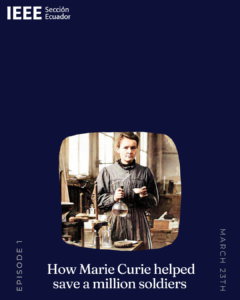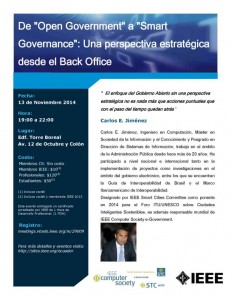
Dalia: Bienvenidos y bienvenidas a “Inglés para ingenieros”, un programa de IEEE sección Ecuador. En cada episodio podrás practicar inglés a tu propio ritmo, escuchando y leyendo artículos de revistas reconocidas en ciencia y tecnología. En cada capítulo, yo te acompañaré, para asegurarme de que entiendas todo.
En este programa te contamos cómo Marie Curie, una reconocida científica polaca-francesa, utilizó su experiencia en radiología para establecer unidades móviles de rayos X en el frente de batalla durante la Primera Guerra Mundial. Su trabajo salvó la vida de miles de soldados al ayudar a los médicos a localizar balas y fragmentos de metralla en los cuerpos de los heridos.
Este Podcast es realizado a partir del artículo de la revista de IEEE Spectrum: How Marie Curie Helped Save a Million Soldiers During World War I. Iniciamos.
Roger: By 1914 Marie Skłodowska Curie had already made several pioneering contributions to the field of radioactivity, including discovering the radioactive elements radium and polonium. When World War I broke out in Europe that year, Curie saw a way to apply her expertise to help save the lives of wounded soldiers.
She realized that the electromagnetic radiation of X-rays could help doctors see the bullets and shrapnel embedded in the soldiers’ bodies and remove them, as well as locate broken bones. Many hospitals in France already had X-ray equipment, but those machines were often far from the battlefield.
To move the technology closer to the soldiers, Curie and her daughter amassed a fleet of vehicles equipped with X-ray machines and set up 200 radiological units in more permanent posts during the first two years of the war.
Dalia: Mari Curie era directora fundadora del servicio de Radiología de la Cruz Roja de Francia en el Instituto del Radio en París en 1914. Cuando comenzó la guerra, ella trasladó la única muestra de radio de Francia a Burdeos, pero regresó rápidamente a París para ayudar en el esfuerzo de guerra.
Roger: Curie, who was born in Poland, was living in Paris in 1914 when the war began. As founding director of France’s Red Cross Radiology Service, she was in the midst of setting up her laboratory at the Radium Institute, a new center in the city for the study of radioactivity. Construction was complete, but many of her researchers were off fighting the war. Just before the German army’s invasion, the French government moved the country’s capital to Bordeaux. Curie transported France’s only sample of radium in a safe-deposit box to the city, 600 kilometers southwest, but she quickly returned to Paris, determined to apply her scientific knowledge to aid the war effort.
Dalia: Curie organizó un proyecto para convertir automóviles en unidades móviles de rayos X para usar en hospitales de campaña. Convenció a amigos ricos para donar autos, a fabricantes franceses para donar equipos de rayos X y talleres locales para equipar los vehículos. En octubre de 1914, se completaron 20 vehículos.
Roger: Curie approached her wealthy friends and colleagues to donate automotive vehicles which when modified could be used as mobile X-ray units. And she persuaded French manufacturers of X-ray equipment to donate it along with portable electric generators. She also asked local body shops to voluntarily outfit the vehicles with the equipment so it could be positioned in field hospitals close to the front. By October 1914, the first of 20 vehicles, which French soldiers dubbed petites Curies (little Curies), were ready.
Dalia: Aunque Marie Curie había dado conferencias sobre rayos X, no tenía experiencia práctica trabajando con ellos. Tomó cursos intensivos para aprender a operar y leer las películas de rayos X, y también aprendió a conducir y reparar automóviles. Con un médico militar y su hija como asistentes, viajó al frente de batalla en octubre de 1914. La cantidad de unidades móviles aumentó rápidamente, y los Curies establecieron un programa de capacitación para mujeres en el Instituto del Radio.
Roger: Although Curie had lectured about X-rays at Sorbonne University (now Paris Sorbonne University), she had no practical experience working with them. So she took crash courses on how to operate the equipment and on human anatomy so she could learn how to read the film. She also learned how to drive a car and how to fix it if necessary. Accompanied by a military doctor and her 17-year-old daughter, Irène, for an assistant, Curie made her trip to the battlefront in October 1914. In less than two years, the number of units had grown substantially, and the Curies had set up a training program at the Radium Institute to teach other women to operate the equipment.
Dalia: Marie Curie utilizó el dinero de su premio Nobel para apoyar el esfuerzo de guerra comprando bonos de guerra franceses, después de ofrecer donar sus medallas de oro al gobierno francés, pero la oferta fue rechazada.
Roger: Curie also opened her wallet to aid the war effort. She was the first woman to receive a Nobel Prize, in 1903, for physics, and she went on to receive the 1911 Nobel Prize in Chemistry. She offered to donate her gold medals to the French government to aid the war effort, but the French National Bank turned her down. Instead, she used most of her Nobel Prize money to buy French war bonds.
Dalia: La guerra terminó el 11 de noviembre de 1918, y un año después su laboratorio en el Instituto del Radio finalmente estaba listo. Allí, se dedicaría a la investigación hasta que murió en 1934 a los 66 años.
Roger: The war ended on 11 November 1918, and a year later her laboratory at the Radium Institute was finally ready. There, she would dedicate herself to research until she died in 1934 at age 66 of aplastic anemia—a rare condition in which the body stops producing enough red blood cells. Her anemia was attributed to the lack of protection from radiation exposure when she operated the mobile X-ray units, as well as the radon gas tubes she carried in her pockets during her research.
Dalia: Gracias por haber escuchado inglés para ingenieros. Un programa de IEEE sección Ecuador que tiene como objetivo mejorar las habilidades del idioma inglés en nuestros miembros y el público en general.
Este episodio fue producido por Ronny Cabrera, voluntario de IEEE que vive en Loja, Ecuador.
Thank you for listening!

